Monitoring the Early Strength Development of Cement Mortar with Piezoelectric Transducers Based on Eigenfrequency Analysis Method
Abstract
:1. Introduction
2. Wave Propagation Monitoring and Eigenfrequency Analysis Method
3. Experimental Method
3.1. Design and Fabrication of Smart Aggregates
3.2. Preparation of the Cement Mortar Test Specimen
3.3. Test Procedure
4. Results and Discussion
5. Conclusions
Supplementary Materials
Author Contributions
Funding
Institutional Review Board Statement
Informed Consent Statement
Data Availability Statement
Conflicts of Interest
References
- Powers, T.C. Structure and physical properties of hardened portland cement paste. J. Am. Ceram. Soc. 1958, 41, 1–6. [Google Scholar] [CrossRef]
- Birgin, H.B.; D’Alessandro, A.; Laflamme, S.; Ubertini, F. Smart Graphite-Cement Composite for Roadway-Integrated Weigh-In-Motion Sensing. Sensors 2020, 20, 4518. [Google Scholar] [CrossRef] [PubMed]
- Liu, X.S.; Gu, Q.H.; Tan, Y.L.; Ning, J.G.; Jia, Z.C. Mechanical Characteristics and Failure Prediction of Cement Mortar with a Sandwich Structure. Minerals 2019, 9, 143. [Google Scholar] [CrossRef] [Green Version]
- Zhang, J.P.; Liu, L.M.; Cao, J.Z.; Yan, X.; Zhang, F.T. Mechanism and application of concrete-filled steel tubular support in deep and high stress roadway. Constr. Build. Mater. 2018, 186, 233–246. [Google Scholar] [CrossRef]
- Zhang, J.P.; Liu, L.M.; Li, Q.H.; Peng, W.; Zhang, F.T.; Cao, J.Z.; Wang, H. Development of cement-based self-stress composite grouting material for reinforcing rock mass and engineering application. Constr. Build. Mater. 2019, 201, 314–327. [Google Scholar] [CrossRef]
- Shi, C.J.; Jimenez, A.F.; Palomo, A. New cements for the 21st century: The pursuit of an alternative to Portland cement. Cem. Concr. Res. 2011, 41, 750–763. [Google Scholar] [CrossRef]
- Arjunan, P.; Silsbee, M.R.; Roy, D.M. Sulfoaluminate-belite cement from low-calcium fly ash and sulfur-rich and other industrial by-products. Cem. Concr. Res. 1999, 29, 1305–1311. [Google Scholar] [CrossRef]
- Marroccoli, M.; Nobili, M.; Telesca, A.; Valenti, G.L. Early hydration of calcium sulfoaluminate-based cements for structural applications. In Proceedings of the International Conference on Sustainable Construction Materials and Technologies, Coventry, UK, 11–13 June 2007; pp. 389–395. [Google Scholar]
- Fernandez-Jimenez, A.M.; Palomo, A.; Lopez-Hombrados, C. Engineering properties of alkali-activated fly ash concrete. ACI Mater. J. 2006, 103, 106–112. [Google Scholar]
- Law, D.W.; Adam, A.A.; Molyneaux, T.K.; Patnaikuni, I. Durability assessment of alkali activated slag (AAS) concrete. Mater. Struct. 2012, 45, 1425–1437. [Google Scholar] [CrossRef]
- Paria, S.; Yuet, P.K. Solidification-stabilization of organic and inorganic contaminants using portland cement: A literature review. Environ. Rev. 2006, 14, 217–255. [Google Scholar] [CrossRef] [Green Version]
- Schmidt, T.; Lothenbach, B.; Romer, M.; Neuenschwander, J.; Scrivener, K. Physical and microstructural aspects of sulfate attack on ordinary and limestone blended Portland cements. Cem. Concr. Res. 2009, 39, 1111–1121. [Google Scholar] [CrossRef]
- Guo, S.C.; Hu, J.; Dai, Q.L. A critical review on the performance of portland cement concrete with recycled organic components. J. Clean. Prod. 2018, 188, 92–112. [Google Scholar] [CrossRef]
- Garcia-Lodeiro, I.; Fernandez-Jimenez, A.; Palomo, A. Variation in hybrid cements over time. Alkaline activation of fly ash-portland cement blends. Cem. Concr. Res. 2013, 52, 112–122. [Google Scholar] [CrossRef]
- Ulm, F.J.; Coussy, O. Modeling of thermochemomechanical couplings of concrete at early ages. J. Eng. Mech.-Asce 1995, 121, 785–794. [Google Scholar] [CrossRef]
- Sajedi, F.; Razak, H.A.; Bin Mahmud, H.; Shafigh, P. Relationships between compressive strength of cement-slag mortars under air and water curing regimes. Constr. Build. Mater. 2012, 31, 188–196. [Google Scholar] [CrossRef] [Green Version]
- Eskandari-Naddaf, H.; Kazemi, R. ANN prediction of cement mortar compressive strength, influence of cement strength class. Constr. Build. Mater. 2017, 138, 1–11. [Google Scholar] [CrossRef]
- Bu, J.W.; Tian, Z.H.; Zheng, S.Y.; Tang, Z.L. Effect of Sand Content on Strength and Pore Structure of Cement Mortar. J. Wuhan Univ. Technol.-Mater. Sci. Ed. 2017, 32, 382–390. [Google Scholar] [CrossRef]
- Lu, S.; Ba, H.J. Corrosion Sensor for Monitoring the Service Condition of Chloride-Contaminated Cement Mortar. Sensors 2010, 10, 4145–4158. [Google Scholar] [CrossRef]
- Kim, J.K.; Kee, S.H.; Futalan, C.M.; Yee, J.J. Corrosion Monitoring of Reinforced Steel Embedded in Cement Mortar under Wet-And-Dry Cycles by Electrochemical Impedance Spectroscopy. Sensors 2020, 20, 199. [Google Scholar] [CrossRef] [Green Version]
- Housner, G.W.; Bergman, L.A.; Caughey, T.K.; Chassiakos, A.G.; Claus, R.O.; Masri, S.F.; Skelton, R.E.; Soong, T.T.; Spencer, B.F.; Yao, J.T.P. Structural control: Past, present, and future. J. Eng. Mech. 1997, 123, 897–971. [Google Scholar] [CrossRef]
- Lee, S.J.; You, I.; Zi, G.; Yoo, D.Y. Experimental Investigation of the Piezoresistive Properties of Cement Composites with Hybrid Carbon Fibers and Nanotubes. Sensors 2017, 17, 2516. [Google Scholar] [CrossRef] [PubMed] [Green Version]
- Yoo, D.Y.; You, I.; Lee, S.J. Electrical Properties of Cement-Based Composites with Carbon Nanotubes, Graphene, and Graphite Nanofibers. Sensors 2017, 17, 1064. [Google Scholar] [CrossRef] [PubMed]
- Zhang, T.T.; Zhang, K.P.; Liu, W.D.; Liao, Y.C. Impact Mechanical Response of a 2-2 Cement-Based Piezoelectric Sensor Considering the Electrode Layer Effect. Sensors 2017, 17, 2035. [Google Scholar] [CrossRef] [PubMed] [Green Version]
- Zhang, T.T.; Liao, Y.C.; Zhang, K.P.; Chen, J. Theoretical Analysis of the Dynamic Properties of a 2-2 Cement-Based Piezoelectric Dual-Layer Stacked Sensor under Impact Load. Sensors 2017, 17, 1019. [Google Scholar] [CrossRef] [PubMed] [Green Version]
- Luo, J.L.; Zhang, C.W.; Li, L.; Wang, B.L.; Li, Q.Y.; Chung, K.L.; Liu, C. Intrinsic Sensing Properties of Chrysotile Fiber Reinforced Piezoelectric Cement-Based Composites. Sensors 2018, 18, 2999. [Google Scholar] [CrossRef] [Green Version]
- Li, H.N.; Li, D.S.; Song, G.B. Recent applications of fiber optic sensors to health monitoring in civil engineering. Eng. Struct. 2004, 26, 1647–1657. [Google Scholar] [CrossRef]
- Lopez-Higuera, J.M.; Cobo, L.R.; Incera, A.Q.; Cobo, A. Fiber Optic Sensors in Structural Health Monitoring. J. Lightwave Technol. 2011, 29, 587–608. [Google Scholar] [CrossRef]
- Di Sante, R. Fibre Optic Sensors for Structural Health Monitoring of Aircraft Composite Structures: Recent Advances and Applications. Sensors 2015, 15, 18666–18713. [Google Scholar] [CrossRef]
- Li, S.; Wu, Z. Development of distributed long-gage fiber optic sensing system for structural health monitoring. Struct. Health Monit.-Int. J. 2007, 6, 133–143. [Google Scholar] [CrossRef]
- Chen, Y.Z.; Xue, X.W. Advances in the Structural Health Monitoring of Bridges Using Piezoelectric Transducers. Sensors 2018, 18, 4312. [Google Scholar] [CrossRef] [Green Version]
- Gu, H.; Song, G.; Dhonde, H.; Mo, Y.L.; Yan, S. Concrete early-age strength monitoring using embedded piezoelectric transducers. Smart Mater. Struct. 2006, 15, 1837–1845. [Google Scholar] [CrossRef]
- Hou, S.; Zhang, H.B.; Ou, J.P. A PZT-based smart aggregate for compressive seismic stress monitoring. Smart Mater. Struct. 2012, 21, 105035. [Google Scholar] [CrossRef]
- Meng, Y.Y.; Yan, S.; Sun, W. Experimental research on damage detection of concrete structures based on piezoelectric smart aggregates. In Proceedings of the 2nd International Conference on Civil Engineering, Architecture and Building Materials (CEABM 2012), Yantai, China, 25–27 May 2012; pp. 1145–1151. [Google Scholar]
- Divsholi, B.S.; Yang, Y.W. Combined embedded and surface-bonded piezoelectric transducers for monitoring of concrete structures. Ndt E Int. 2014, 65, 28–34. [Google Scholar] [CrossRef]
- Kong, Q.Z.; Fan, S.L.; Bai, X.L.; Mo, Y.L.; Song, G.B. A novel embeddable spherical smart aggregate for structural health monitoring: Part I. Fabrication and electrical characterization. Smart Mater. Struct. 2017, 26, 095050. [Google Scholar] [CrossRef]
- Kong, Q.Z.; Fan, S.L.; Mo, Y.L.; Song, G.B. A novel embeddable spherical smart aggregate for structural health monitoring: Part II. Numerical and experimental verifications. Smart Mater. Struct. 2017, 26, 095051. [Google Scholar] [CrossRef]
- Zou, D.J.; Du, C.C.; Liu, T.J.; Li, W.J. Effects of temperature on the performance of the piezoelectric-based smart aggregates active monitoring method for concrete structures. Smart Mater. Struct. 2019, 28, 035016. [Google Scholar] [CrossRef]
- Zhou, L.Z.; Zheng, Y.; Song, G.B.; Chen, D.D.; Ye, Y.X. Identification of the structural damage mechanism of BFRP bars reinforced concrete beams using smart transducers based on time reversal method. Constr. Build. Mater. 2019, 220, 615–627. [Google Scholar] [CrossRef]
- Gao, W.H.; Li, H.N.; Ho, S.C.M. A Novel Embeddable Tubular Piezoceramics-Based Smart Aggregate for Damage Detection in Two-Dimensional Concrete Structures. Sensors 2019, 19, 1501. [Google Scholar] [CrossRef] [Green Version]
- Gudmundson, P. Eigenfrequency changes of structures due to cracks, notches or other geometrical changes. J. Mech. Phys. Solids 1982, 30, 339–353. [Google Scholar] [CrossRef]
- Lee, Y.S.; Chung, M.J. A study on crack detection using eigenfrequency test data. Comput. Struct. 2000, 77, 327–342. [Google Scholar] [CrossRef]
- Liang, R.Y.; Hu, J.L.; Choy, F. Theoretical-study of crack-induced eigenfrequency changes on beam structures. J. Eng. Mech. -Asce 1992, 118, 384–396. [Google Scholar] [CrossRef]
- Zhang, Y. Eigenfrequency Computation of Beam/Plate Carrying Concentrated Mass/Spring. J. Vib. Acoust.-Trans. Asme 2011, 133, 021006. [Google Scholar] [CrossRef]
- Tomlinson, D.; Moradi, F.; Hajiloo, H.; Ghods, P.; Alizadeh, A.; Green, M. Early age electrical resistivity behaviour of various concrete mixtures subject to low temperature cycling. Cem. Concr. Compos. 2017, 83, 323–334. [Google Scholar] [CrossRef]
- Sidney Mindess, J.F.Y.; David, D. Concrete, 2nd ed.; Pearson Education Inc.: Upper Saddle River, NJ, USA, 2003; pp. 404–405. [Google Scholar]
- Mariak, A.; Kurpinska, M.; Wilde, K. Maturity curve for estimating the in-place strength of high performance concrete. In Proceedings of the 64th Scientific Conference of the Committee-for-Civil-Engineering-of-the-Polish-Academy-of-Sciences and the Science-Committee-of-the-Polish-Association-of-Civil-Engineers (PZITB) (KRYNICA), Krynica Zdroj, Poland, 16–20 September 2018. [Google Scholar]
- Belykh, I.; Sopov, V.; Butska, L.; Pershina, L.; Makarenko, O. Predicting the strength and maturity of hardening concrete. MATEC Web Conf. 2018, 230, 03001. [Google Scholar] [CrossRef]
- Jiang, P.; Jiang, L.H.; Zha, J.; Song, Z.J. Influence of temperature history on chloride diffusion in high volume fly ash concrete. Constr. Build. Mater. 2017, 144, 677–685. [Google Scholar] [CrossRef]
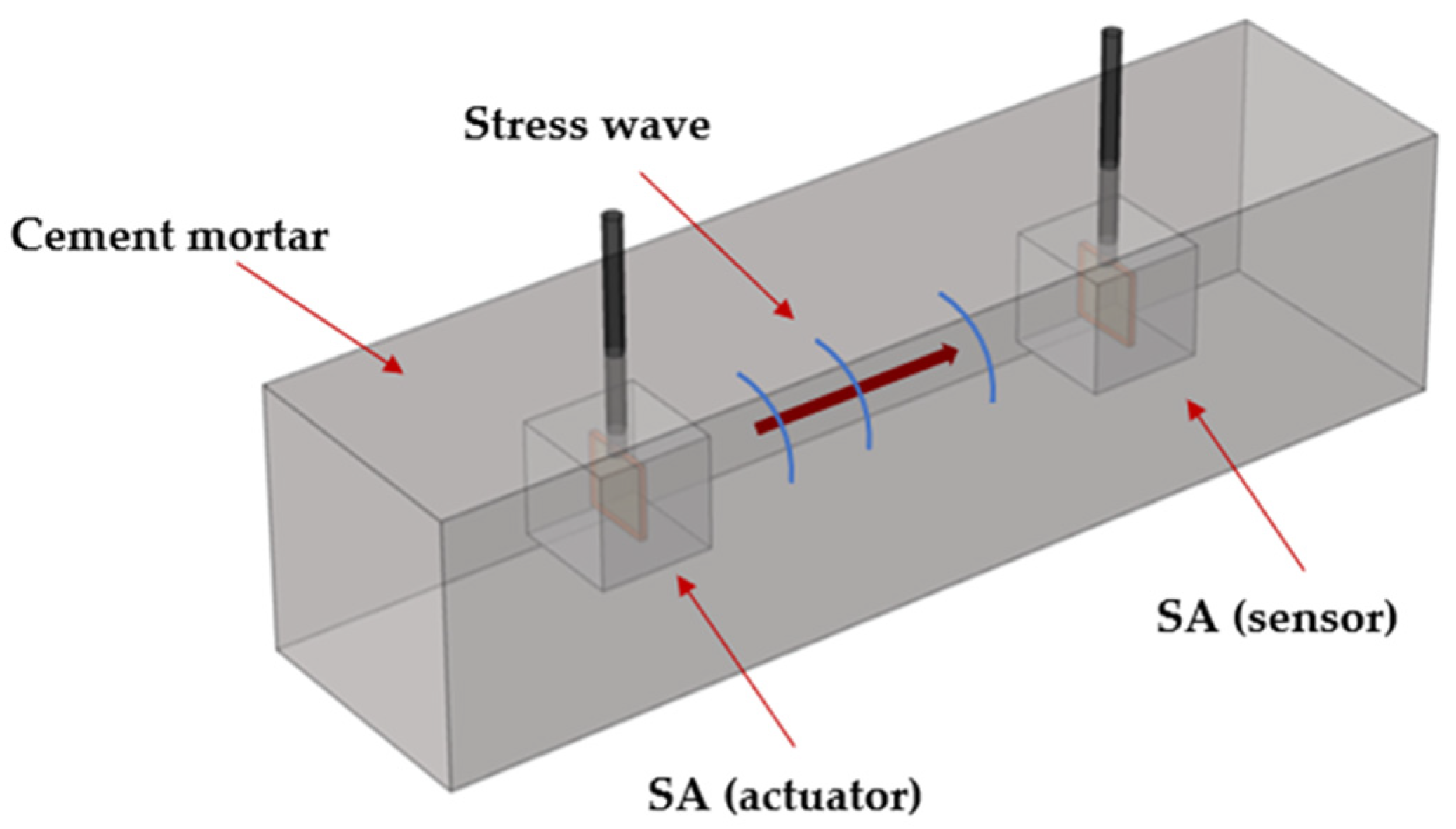
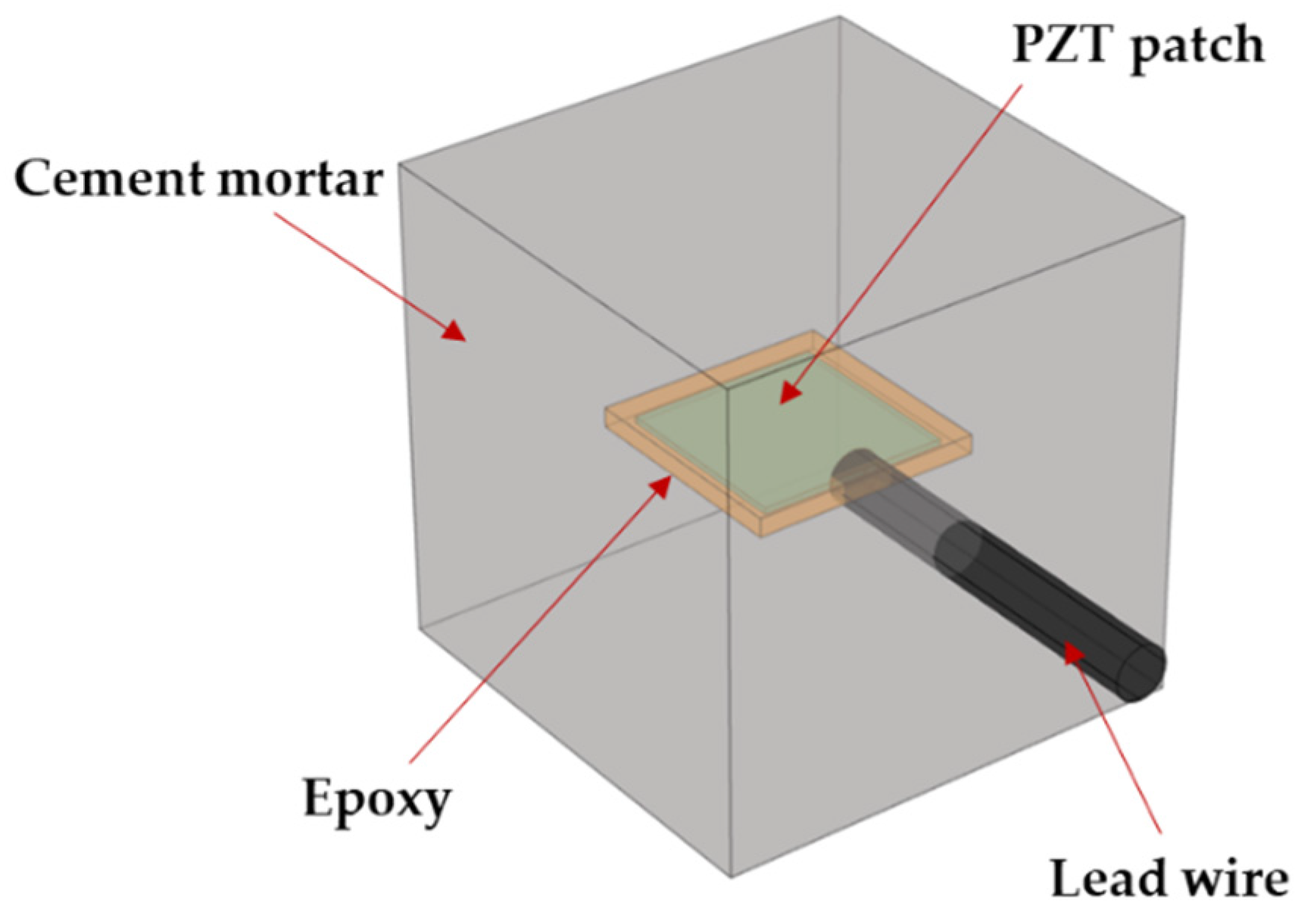

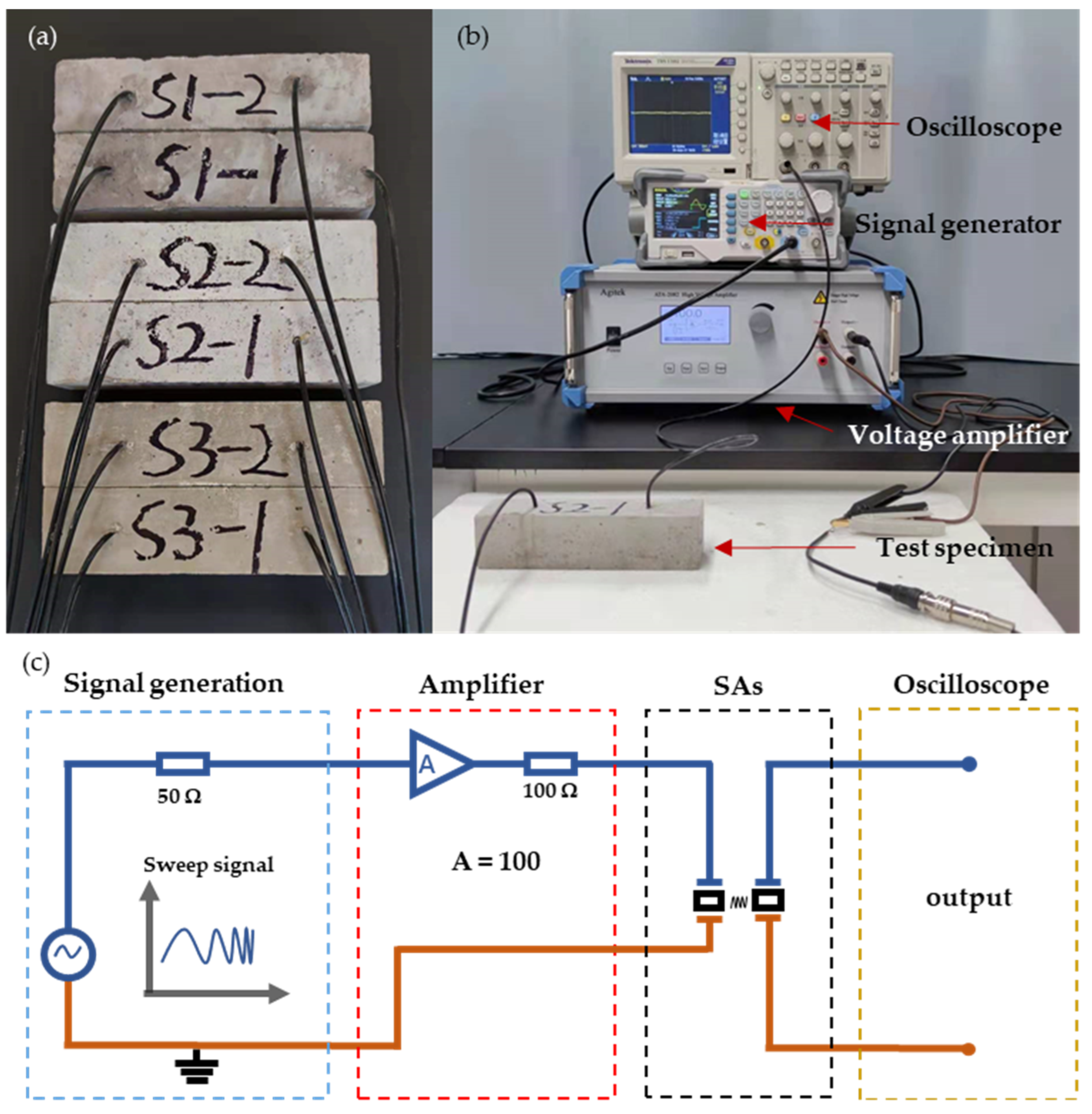
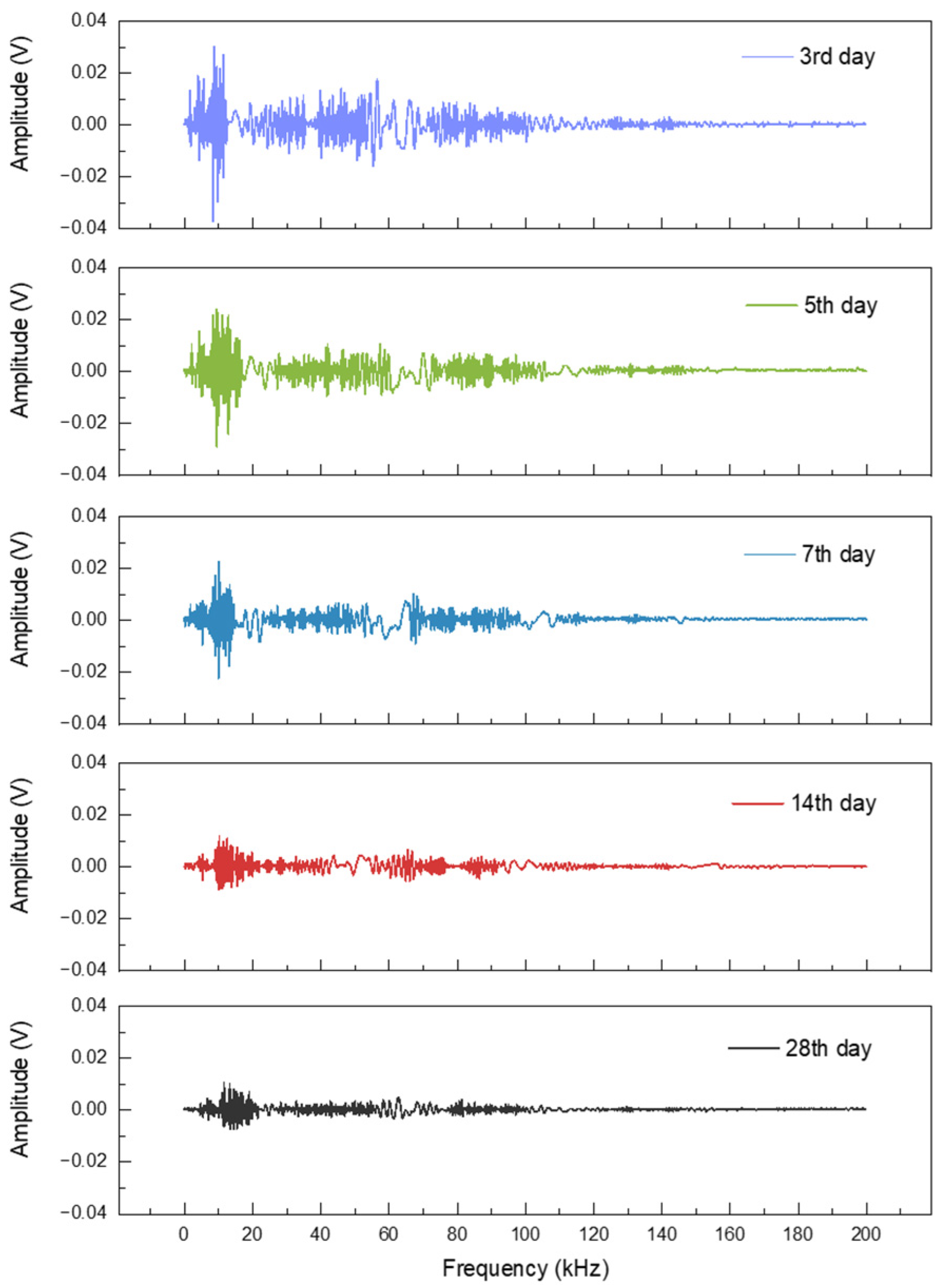
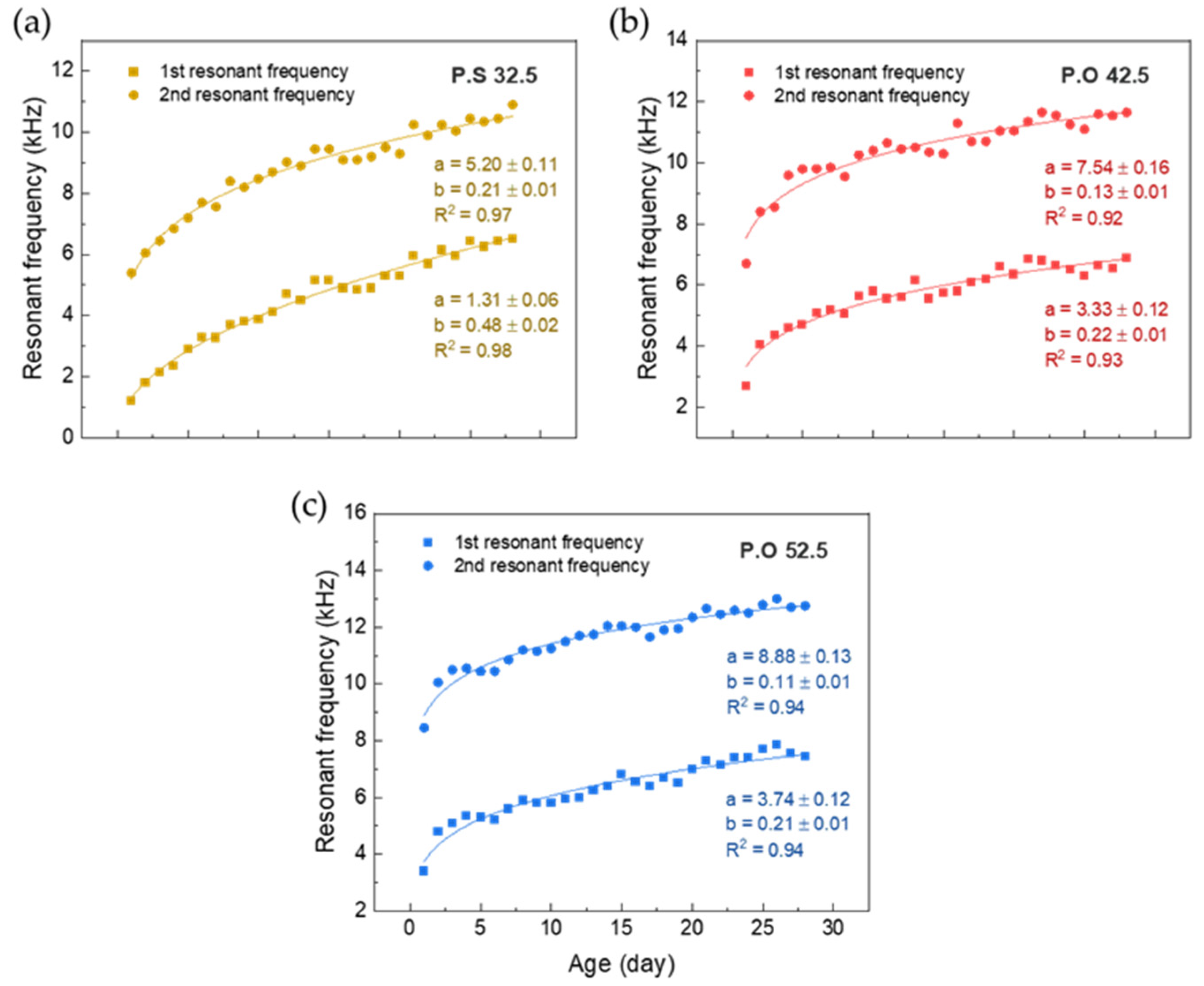
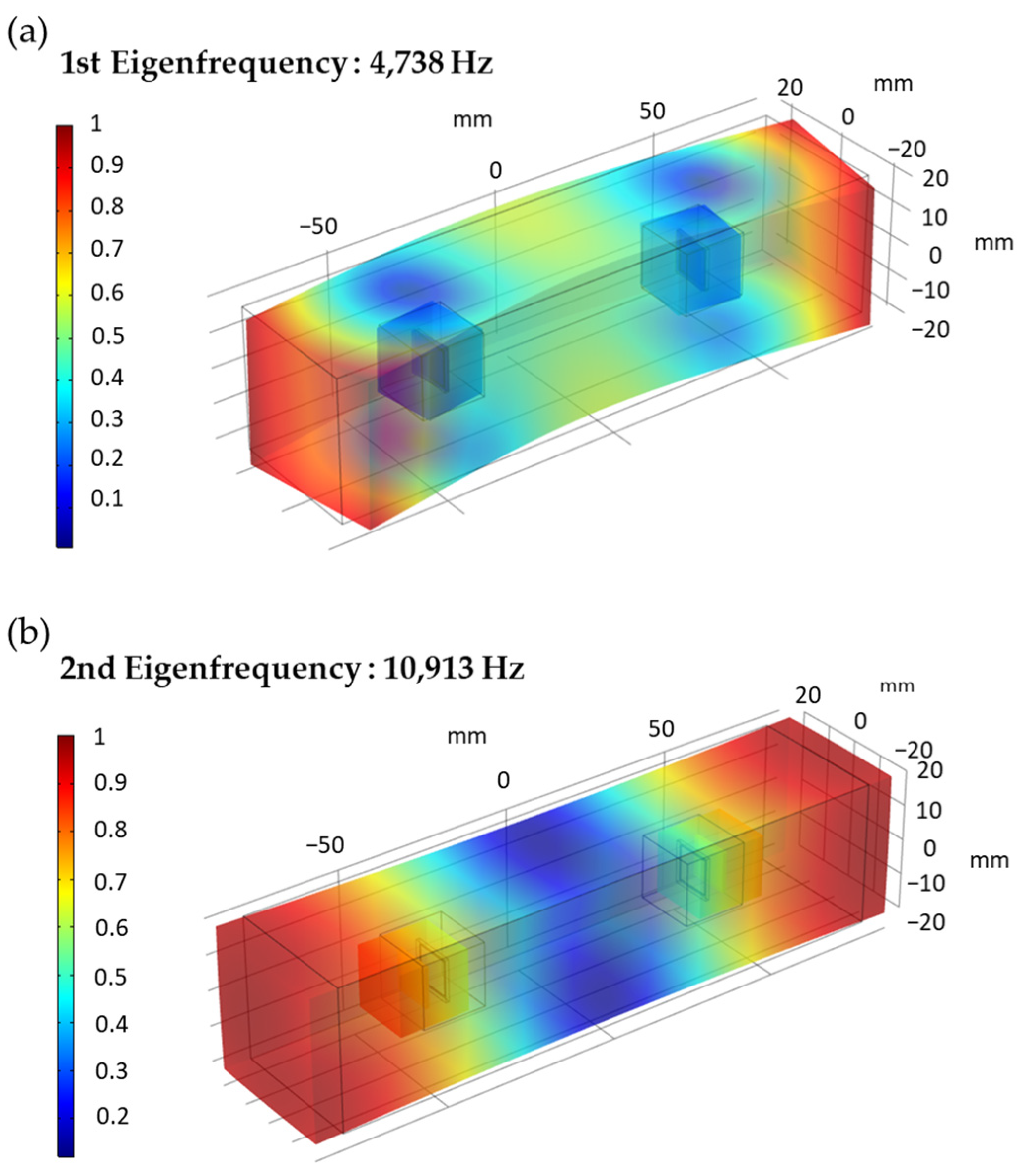
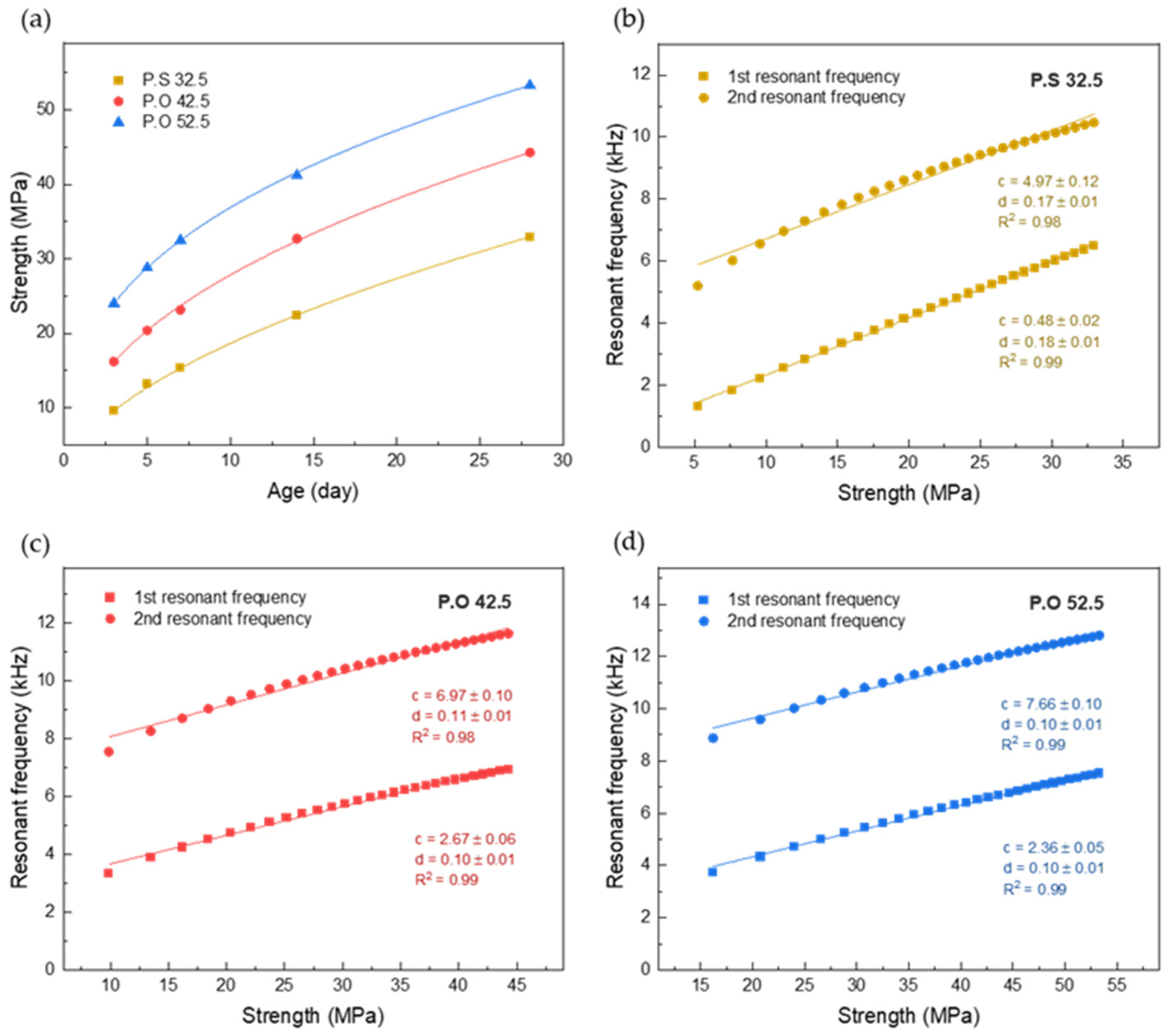
| Parameter | Numerical Value | Unit |
|---|---|---|
| Density | 7.45 | 103 kg/m3 |
| Young’s modulus | 46 | GPa |
| Mechanical quality factor | 70 | / |
| Poisson ratio | 0.33 | / |
| Planar electromechanical coupling factor | 0.65 | / |
| d31, d32 | −186 | 10−12 C/N |
| d33 | 670 | 10−12 C/N |
| Specimens | Cement Type | Cement Content (g) | Sand (g) | Water (g) |
|---|---|---|---|---|
| S1 | Portland slag cement 32.5 | 300 | 900 | 150 |
| S2 | Portland cement 42.5 | |||
| S3 | Portland cement 52.5 |
Publisher’s Note: MDPI stays neutral with regard to jurisdictional claims in published maps and institutional affiliations. |
© 2022 by the authors. Licensee MDPI, Basel, Switzerland. This article is an open access article distributed under the terms and conditions of the Creative Commons Attribution (CC BY) license (https://creativecommons.org/licenses/by/4.0/).
Share and Cite
Wang, G.; Qiu, W.; Wang, D.; Chen, H.; Wang, X.; Zhang, M. Monitoring the Early Strength Development of Cement Mortar with Piezoelectric Transducers Based on Eigenfrequency Analysis Method. Sensors 2022, 22, 4248. https://doi.org/10.3390/s22114248
Wang G, Qiu W, Wang D, Chen H, Wang X, Zhang M. Monitoring the Early Strength Development of Cement Mortar with Piezoelectric Transducers Based on Eigenfrequency Analysis Method. Sensors. 2022; 22(11):4248. https://doi.org/10.3390/s22114248
Chicago/Turabian StyleWang, Guocheng, Wenying Qiu, Dongkai Wang, Huimin Chen, Xiaohao Wang, and Min Zhang. 2022. "Monitoring the Early Strength Development of Cement Mortar with Piezoelectric Transducers Based on Eigenfrequency Analysis Method" Sensors 22, no. 11: 4248. https://doi.org/10.3390/s22114248
APA StyleWang, G., Qiu, W., Wang, D., Chen, H., Wang, X., & Zhang, M. (2022). Monitoring the Early Strength Development of Cement Mortar with Piezoelectric Transducers Based on Eigenfrequency Analysis Method. Sensors, 22(11), 4248. https://doi.org/10.3390/s22114248








